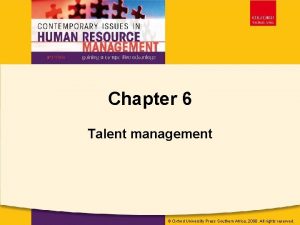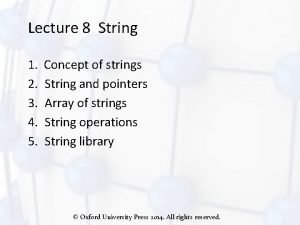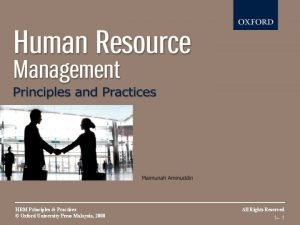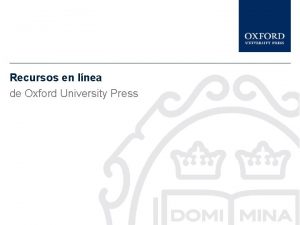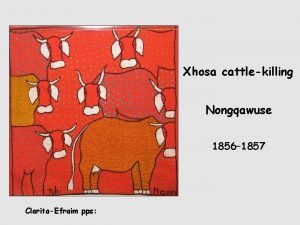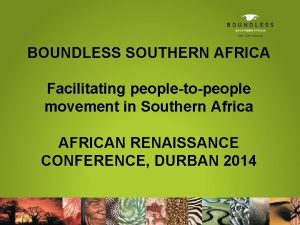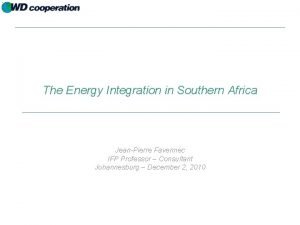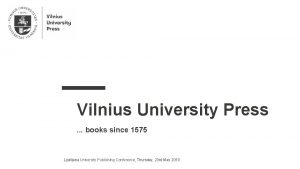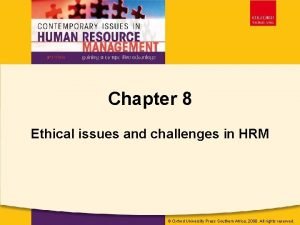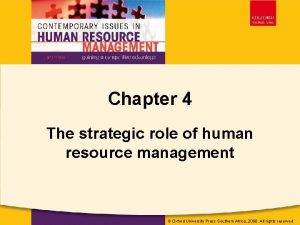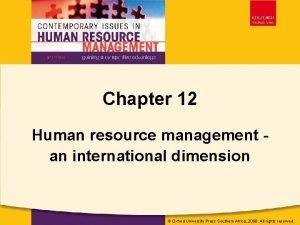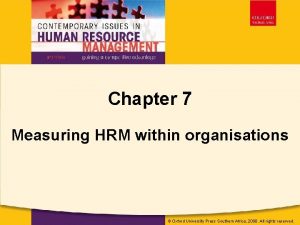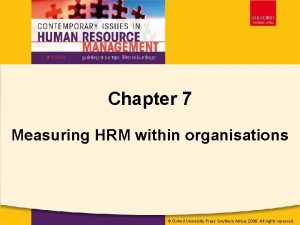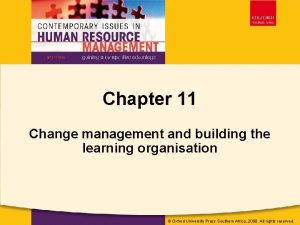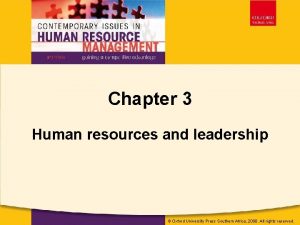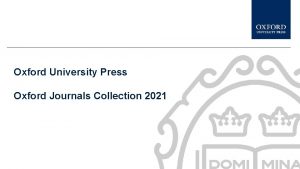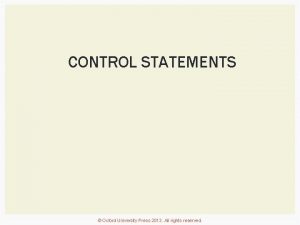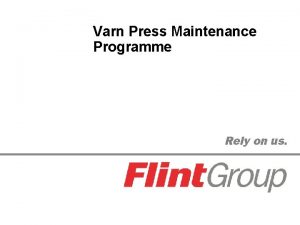Oxford University Press Southern Africa 2008 All rights




























- Slides: 28

© Oxford University Press Southern Africa, 2008. All rights reserved. Chapter 6 Talent management © Oxford University Press Southern Africa, 2008. All rights reserved.

© Oxford University Press Southern Africa, 2008. All rights reserved. Learning outcomes After reading this chapter you should be able to: • define the concept "talent" • discuss the changing dynamics of the workplace in the 21 st century facilitating an increased emphasis on talent management • list the five key areas to make talent a source of competitive advantage • discuss the reasons for the perceived increasing skills shortages • discuss strategies for dealing with the 'war for talent'

© Oxford University Press Southern Africa, 2008. All rights reserved. Chapter Content • Opening case: Developing talent at Kyphon and Triage - different but similar • Introduction • The concept of ‘talent’ • changing dynamics of the workplace in the 21 st century • human capital theory and the resource based view (RBV) of the company • reasons for the increasing skills shortage in the world • new paradigm to make talent a source of competitive advantage • dealing with the ‘war for talent’

© Oxford University Press Southern Africa, 2008. All rights reserved. Talent management • recognition of the role of HR has come at a time of major change in the nature of the labour market • generation of workers that are focused on employability rather than employment • if organisations are to remain competitive the management of talented employees will be a key focus and fundamentally different to the latter half of the 20 th century

© Oxford University Press Southern Africa, 2008. All rights reserved. Attraction and retention – theoretical perspective • human capital theory = links investment in the organisation's key asset (its employees) to increased productivity and sustained competitive advantage – strategic aspect is the long-term enhancement of the firm's resource base by linking employee skill development with retention through training and development, career management and progression

© Oxford University Press Southern Africa, 2008. All rights reserved. Attraction and retention – theoretical perspective • resource based view = focus is on an organisation retaining and developing these human resources through investments such as human resource development (HRD) strategies – will ensure that these assets become valuable, rare and difficult to imitate, enhancing further the organisation's competitive advantage

© Oxford University Press Southern Africa, 2008. All rights reserved. Attraction and retention – theoretical perspective • management of learning and knowledge within organisations in an ever more complex role for HRM in the creation of a competitive advantage • organisations must commit resources to develop a diverse and adaptive approach – to ensure that each area within the organisation has access to appropriate levels of training and development → to meet diverse organisational objectives

© Oxford University Press Southern Africa, 2008. All rights reserved. Talent management and the demographic time bomb • incorporates the cooperation and communication of managers at all levels • include workforce planning, talent gap analysis, recruitment, selection, education and development, retention, talent reviews, succession planning and evaluation

Talent management system

© Oxford University Press Southern Africa, 2008. All rights reserved. Talent management and the demographic time bomb • talent = the sum of the person's abilities – his/her intrinsic gifts, skills, knowledge, experience, intelligence, judgement, attitude, character and drive. It also includes his/her ability to learn and grow • population trends • finding more imaginative ways to attract and retain this talent

© Oxford University Press Southern Africa, 2008. All rights reserved. Talent shortage survey 1. 2. 3. Sales representatives Engineers Technicians (production/operations, engineering and maintenance) 4. Production operators 5. Skilled manual trades (carpenters, welders and plumbers) 6. IT staff (programmes/developers) 7. Administrative/personal assistants 8. Drivers 9. Accountants 10. Management/executives

© Oxford University Press Southern Africa, 2008. All rights reserved. Old and new business reality Old reality People need companies Machines, capital and geography are the competitive advantage Better talent makes some difference Jobs are scarce Employees are loyal and jobs are secure People accept the standard package they are offered New reality Companies need people Talented people are the competitive advantage Better talent makes a huge difference Talented people are scarce People are mobile and their commitment is short term People demand much more

© Oxford University Press Southern Africa, 2008. All rights reserved. Old and new ways of doing things Old reality New reality HR is responsible for people management We provide good pay and benefits Recruiting is like purchasing We think development happens in training We treat everyone the same and like to think that everyone is equally capable All managers, starting with the CEO, are accountable for strengthening their talent pool We shape our company, our jobs, even our strategy to appeal to talented people Recruiting is like marketing We fuel development primarily through stretch jobs, coaching and mentoring We affirm all our people but invest differently in our A, B and C players

© Oxford University Press Southern Africa, 2008. All rights reserved. Building a new paradigm Five key areas for organisations to act upon if they were going to make talent a source of competitive advantage: • • • embrace a talent mindset craft a winning employee value proposition rebuild your recruitment strategy weave development into your organisation differentiate and affirm your people

© Oxford University Press Southern Africa, 2008. All rights reserved. Embrace a talent mindset Old talent mindset New talent mindset A vague notion that "people are A deep conviction that better our most important asset“ talent leads to better corporate performance All managers are accountable HR is responsible for people for strengthening their talent management pool Talent management is a central We do a two-day succession part of how we run the company planning exercise once a year I take bold actions to build the talent pool I need I work with people I inherit

© Oxford University Press Southern Africa, 2008. All rights reserved. Embrace a talent mindset Five key actions that leaders must take: • get involved in people decisions • develop probing talent reviews • instil a talent-focused mindset within the organisation • invest real money in talent • be accountable for talent management

Craft a winning EVP

© Oxford University Press Southern Africa, 2008. All rights reserved. Rebuild your recruitment strategy • understand the new workforce • imperative to remain a creative recruitment and selection strategy even in downturn – skills shortage is a long term proposition • organisations can continue to absorb new talent

© Oxford University Press Southern Africa, 2008. All rights reserved. Rebuild your recruitment strategy Old recruiting strategies New recruiting strategies Grow your own talent Recruit for vacant positions Go to a few traditional sources Advertise to job hunters Specify a compensation range and stay within it Recruiting is about screening Hire as needed with no overall plan Pump talent in at all levels Hunt for talent at all times Tap many diverse pools of talent Find ways to reach passive candidates Break the compensation rules to get the candidates you want Recruiting is about selling as well as screening Develop a recruiting strategy for each type of talent

© Oxford University Press Southern Africa, 2008. All rights reserved. Rebuild your recruitment strategy • attraction – values and ethics (employees become more discerning about the companies they work for) – blogs and websites • organisation fit and retention – smart organisations are defining what type of person will fit with the organisation's culture (a lot of that is value-driven - not just what they are capable of doing, but what satisfies them)

© Oxford University Press Southern Africa, 2008. All rights reserved. Weave development into the organisation • opportunities and challenges – employees are looking for work that provides opportunities and is challenging – organisations must develop talent at all levels (integrated into the culture of the organisation) – one of the main reasons for employees seeking alternative employment is to pursue more interesting work elsewhere – in light of the skills shortages employers need to review the way that jobs are constructed and connected

© Oxford University Press Southern Africa, 2008. All rights reserved. Weave development into the organisation • provision of training and development – training opportunities can be a deciding factor for employees to stay/leave – resistance to investment in training and development – organisational resistance to investment in T&D, changing psychological contract – important lure for ‘war for talent’

© Oxford University Press Southern Africa, 2008. All rights reserved. Development Old development strategies Development just happens Development means training The unit owns the talent Only poor performers have development needs A few lucky people find mentors New development strategies Development is woven into the fabric of the organisation Development primarily means challenging experiences, coaching, feedback and mentoring The company owns the talent; people move easily around the company Everyone has development needs, and receives coaching Mentors are assigned to every highpotential person

© Oxford University Press Southern Africa, 2008. All rights reserved. Differentiate and affirm your people • Soft approach to HRM – invest heavily in star performers – solid employees are developed to contribute their best to retain them – poor performers are helped to improve their performance • Hard approach to HRM – exit strategy → if the soft approach does not work to change the employee’s performance

© Oxford University Press Southern Africa, 2008. All rights reserved. Differentiate and affirm your people • approach is used to produce a potential star focused culture in the organisation which undermines a team culture • others are of the opinion that this approach simply recognises an individual's achievement (as long as it is not overt it will not affect the performance of the organisation) • awareness of the diverse lifestyles and needs – areas of work/life balance, family-friendly benefits and diversity may be seen only as attraction strategies – allowing employees the flexibility to meet personal needs becomes an important retention factor → adding to 'employer of choice' standing

© Oxford University Press Southern Africa, 2008. All rights reserved. Differentiate and affirm your people • Pocock – link between: work/life balance worker attraction and retention ultimate competitive survival of the company • in the number of women in the workforce + ageing population base (requiring part-time work/ carers) elevates the need for organisations to support valued employees who have family responsibilities

© Oxford University Press Southern Africa, 2008. All rights reserved. Differentiate and affirm your people • child care problems and some parents' decision to return to work • research findings – development of flexible work patterns has been a key factor in improving retention – increase in return from maternity leave, low turnover and employee feedback identifiable criteria – opportunity to attract a wider range of talent – negative effect of not capitalising on workers from a wide range of backgrounds – companies employing diversely experienced employees are likely to be more creative and thus better able to meet the expectations of a diverse market

© Oxford University Press Southern Africa, 2008. All rights reserved. Talent management in practice • How can an organisation achieve sustained competitive advantage by embracing talent management? – Software Co example üoutcomes
 Oxford university press south africa
Oxford university press south africa Damon zucca
Damon zucca M.swan (oxford university press)
M.swan (oxford university press) Strlen( oxford university press ) is
Strlen( oxford university press ) is Oxford university press malaysia
Oxford university press malaysia Oxford university press
Oxford university press Oxford university press
Oxford university press 2008 2008
2008 2008 Nongqawuse grave
Nongqawuse grave Chapter 24 southern africa
Chapter 24 southern africa Volvo group southern africa
Volvo group southern africa Boundless southern africa
Boundless southern africa Southern african transport conference
Southern african transport conference Chartered secretaries southern africa
Chartered secretaries southern africa Southern africa
Southern africa Cambridge university press
Cambridge university press Cambridge university press 2011
Cambridge university press 2011 Vilnius university press
Vilnius university press Cambridge university press 2011
Cambridge university press 2011 Positive rights vs negative rights
Positive rights vs negative rights What are littoral rights
What are littoral rights Duties towards self
Duties towards self Legal rights and moral rights
Legal rights and moral rights Positive vs negative rights
Positive vs negative rights Negative rights vs positive rights
Negative rights vs positive rights Rosalind hursthouse
Rosalind hursthouse Positive rights and negative rights
Positive rights and negative rights Opposite rays
Opposite rays Southern federal university
Southern federal university
